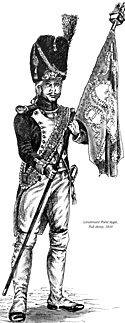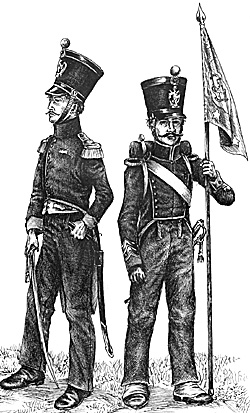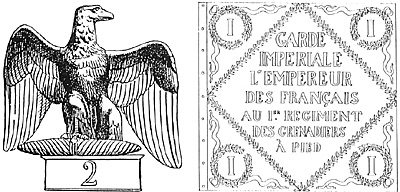 The guard carried flags very similar in design to those issued to the Line regiments in 1804. The basic pattern was an 80cm square Drapeau (or colour) for the infantry. The heavy cavalry carried a 60cm square standard. A 60cm by 70cm guidon with rounded swallow tails was carried by the light cavalry and by the foot and horse artillery. In all three styles of flag the central device was a large white diamond with alternate blue and red corner triangles.
The guard carried flags very similar in design to those issued to the Line regiments in 1804. The basic pattern was an 80cm square Drapeau (or colour) for the infantry. The heavy cavalry carried a 60cm square standard. A 60cm by 70cm guidon with rounded swallow tails was carried by the light cavalry and by the foot and horse artillery. In all three styles of flag the central device was a large white diamond with alternate blue and red corner triangles.
Lieutenant Porte-Aigle, Full dress, 1810
Inside the white diamond on the reverse side of each flag was a crowned, gold eagle clutching a thunderbolt in its talons. On the reverse of the artillery flag the eagle stood above crossed cannon and on the reverse of the flag of Marins it stood before an anchor. On the left of the eagle were the words VALEUR ET and to the right DISCIPLINE. Below the eagle was the squadron or battalion number (i.e. 1er ESCADRON or 2 eme BATAILLON). All the lettering was in gold. The obverse bore the word L'EMPEREUR DES FRANCAIS AU REG, then followed the regimental title, and below this, the words DE LA GARDE IMPERIALE. An exception to this general rule was the Drapeau of the Gendarmerie d'Elite a Pied which bore no eagle on its reverse, merely the above lettering. The Gendarmes A Cheval, conversely, did carry an eagle on its standard. In each corner triangle was a gold wreath, inside which was either a gold "N" monogram or a symbol of the regiment's designation. These were a hunting horn for Chasseurs, a grenade for Grenadiers and an anchor for the Marins. Until 1813 the guidon of the Chasseurs a Cheval carried an Imperial coat-of-arms on the reverse in place of the eagle.
The flags were carried on blue staves of two meters length. Each regiment was issued with a bronze eagle which was screwed onto a bronze plinth to which was welded a tubular socket into which the stave was fitted. On the plinth above the raised right claw of the eagle, was a cast Jupiter's spindle. On both front and rear faces of the plinth was the regimental number, except for that of the Marins which instead bore an anchor. Together the plinth and eagle measured approximately ten inches in height.
 Left: Officer of Tirailleurs, campaign dress 1815.
Left: Officer of Tirailleurs, campaign dress 1815.
Right: Sgt. Major with fanion, Tirailleurs 1815-15.
Initially it was intended to issue eagles to every battalion and squadron. However, even though the Guard continued to expand, no further eagles were received by the Guard until 1810 when the 2nd (Dutch) and the 3rd Grenadiers a Pied were formed. The following year Napoleon decreed that eagles were only to be carried by infantry units whose strength exceeded 1,200 men and cavalry formations which numbered over 600 sabres. This meant, in effect, that each regiments - both horses and foot - was restricted to just one eagle apiece. The Young Guard regiments were never issued with eagles, each regiment's allegiance to the Emperor being transmitted, as it were, through the eagle of its parent corps (e.g. the Tirailleur-chasseurs through the Chasseurs a Pied).
The formation of the new Guards regiments led to a renumbering and renaming of some of the existing regiments and new flags had to be issued. These new flags differed from the old ones only in that the regimental number now appeared in all the corner wreathe and that the reverse no longer bore an eagle. The inscription on the reverse read GARDE IMPERIALE L'EMPEREUR DES FRANCAIS AU ... REGIMENT then followed the regimental title.
In 1813 colours of a completely different design were distributed to all the Guard regiments. Only one flag was issued to each regiment. Unlike the previous flags, which were made of painted, single sheets of silk, the new colours; were of a double thickness of fine silk.
 Eagle, 2me Grenadiers a Pied
Eagle, 2me Grenadiers a Pied
Drapeau, 1er Grenadiers a Pied, 1811-13.
They were heavily embroidered with gold wire and were finished with gold fringes, gold cords, and a velvet cravat also with gold fringes. The new design was based on the Tricolour (blue against the stave, then white, and red on the fly) with an inscription on the obverse which read GARDE IMPERIALE L'EMPEREUR NAPOLEON AU ... REGIMENT followed by the regimental title. On the reverse were listed the battle honours of the Guard, which were identical for each regiment. The colours; each bore four wreaths on each face. Within the top and bottom wreaths was the regimental badge (grenade, hunting horn, etc.) and in the two side wreaths was the letter N.
Following Napoleon's abdication in 1814 the restored monarchy ordered all eagles to be destroyed. The small force which followed Napoleon into exile - the Bataillon Napoleon - was issued with a special eagle which bore the words ISLE D'ELBA on its plinth. This battalion also had its own colour which had a white field with a diagonal crimson stripe on which were three gold bees. On the bottom of the flag, next to the stave, was the word NAPOLEON and at the top, on the fly, was the word BATAILLON. This lettering was in crimson. The stave was painted in crimson and white, and it carried a crimson and white, gold fringed, cravat and gold cords.
With Napoleon's return to power in 1815 new eagles and colours were presented to the Guard, but only the colour of the Artillierie ~ Cheval has survived to the present day. This flag is similar to the 1812 issue in that it is based again on the Tricolour. On the obverse appear the battle honours MARENGO, ULM AUSTERLITZ, JENA EYLAU, FRIEDLAND WAGRAM, LA MOSKOWA LUTZEN, MONTMIRAIL. On the reverse are the names VIENNE, BERLIN MADRID, MILAN MOSCOW, VARSOVIE VIENNE, LA CAIRE. The wreaths on both faces enclose a letter N. The 1815 design of eagle was a copy of the 1804 original but with less detail due to the urgency with which they had to be produced. Only six flags and eagles were issued to the Guard in 1815 - on each to the horse and foot Grenadiers and Chasseurs, and two to the artillery.
Although neither the Middle or Young Guard regiments were issued with eagles or colours they did carry battalion permons. On 10 March 1812, Napoleon ordered that every Guard battalion was to have a fanion, white for Tirailleurs and red for Voltigeurs. Only one of each of these is still in existence. One measures approximately 80cm by 75cms and has a red field with a simple green wreath below a white eagle with a yellow crown. Inside the wreath is a large white N and in alternate corners are white grenades and white hunting horns. It is believed to have belonged to the 1st Voltigeurs. The other has a white field with gold grenades and hunting horns in the corners, and a crowned eagle in the centre, all in gold. The hunting horns carry the regimental number. This pennon is believed to have belonged to the 13th Tirailleurs.
Back to Age of Napoleon 18 Table of Contents
Back to Age of Napoleon List of Issues
Back to MagWeb Master List of Magazines
© Copyright 1996 by Partizan Press.
This article appears in MagWeb (Magazine Web) on the Internet World Wide Web.
Other military history articles and gaming articles are available at http://www.magweb.com